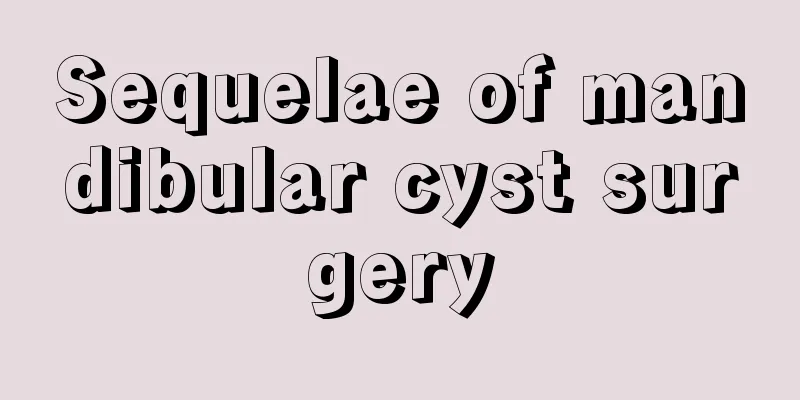Sequelae of mandibular cyst surgery

|
Mandibular cyst is a kind of swelling that grows on the mandible. Under normal circumstances, such a cyst will contain some fluid, and the pus will gradually grow larger. Mandibular cyst is a disease that generally occurs among young people. When suffering from mandibular cysts, patients will feel particularly uncomfortable. Currently, the treatment of mandibular cysts involves surgical removal. Mandibular cyst surgery complications 1. After the mandibular cyst surgery, if the operation range is large and the mandibular nerve canal is damaged, it may cause numbness of the lower lip and mandibular gums. You can use nerve nourishing drugs and do physical therapy to slowly recover, but if it takes a long time, it cannot be recovered. 2. The main complication of extraoral mandibular cyst removal is postoperative infection. In addition to the preventive measures mentioned above for the intraoral method, for cases with large mandibular cysts and thin buccal bone plates, the buccal bone plates can be removed and the lower edge of the mandible and the lingual bone plates can be retained, and a pressure bandage can be applied to the face to reduce the wound cavity. At the same time, intermaxillary fixation is performed to prevent pathological fractures. There are also cases where the buccal bone plate, periosteum and buccal tissue flap are turned up together before the cyst is removed. In this way, the buccal bone plate can be retained. It is worth emphasizing that maintaining unobstructed drainage is an important measure to prevent postoperative infection. Precautions In addition to the parts described in the intraoral method, the following points should be noted: ① When making an incision and flap in the submandibular area, damage to the marginal branch of the facial nerve should be avoided; ② When the inner bone plate of the mandibular ascending ramus is damaged, the cyst wall should be carefully peeled off to avoid damage to deep important nerves and blood vessels; ③ If the oral cavity is penetrated, the oral mucosa should be tightly sutured to maintain good extraoral drainage. This surgery is a radical procedure. The key to the operation is to completely remove the cyst wall while avoiding penetration or damage to adjacent anatomical structures. Therefore, the operating procedures should be strictly followed during the processes of flap opening, window opening, and cyst dissection. In addition, attention should be paid to the reasonable design of incisions and the correct treatment of intraoral wounds to prevent the occurrence of complications. ① Properly handle the teeth associated with the cyst; ② The incision should be designed reasonably and the intraoral wound should be sutured tightly to prevent wound dehiscence and fistula formation; ③Antibiotic powder can be placed in the bone cavity; ④ Antibiotics were selected after surgery. In addition, it is generally believed that for smaller cysts, after the cyst is removed, the blood can be allowed to fill the bone cavity, antibiotic powder can be added, and then the wound can be sutured tightly; however, for larger cysts, this method should not be used, and the blood clot should be thoroughly removed. |
<<: Tips on how to get rid of acne and acne marks
>>: Can soy isoflavones remove acne?
Recommend
How can a boy have a melon-seed face
Nowadays, people love beauty very much. No matter...
What does eugenics genetic test include?
Today's society advocates eugenics and good p...
You can't grow taller by sunbathing
Many people like to sunbathe because it makes peo...
What are the symptoms of patients with advanced liver cancer before death? These three symptoms often appear in the advanced stage of liver cancer
Liver cancer is a malignant tumor that occurs in ...
Is it better to store the placenta or umbilical cord blood?
In many big cities, after the baby is born in the...
What are the effects and functions of aloe vera water?
I believe everyone knows aloe vera, especially ha...
What to do if your shoes pinch your toes
Some people may get their toes pinched by their s...
What are the side effects of morphine
Morphine is a commonly used sedative and analgesi...
How to effectively remove nodular acne
Nodular acne is also a type of acne in which red ...
Symptoms of arrhythmia, take it seriously
Arrhythmia is an important group of cardiovascula...
Pustules on the head and hair loss
Hair loss is a relatively normal phenomenon. Unde...
What to eat when you have hypoglycemia symptoms
Hypoglycemia means that blood sugar is too low, w...
What is the cause of back pain? Be alert to disease factors
Sometimes back pain will get better by resting, w...
Can liver cancer patients eat Cordyceps sinensis? Yes, but it has no therapeutic effect
Cancer is a wasting disease, so nutrition needs t...
What can children eat to improve immunity?
Nowadays, many children are getting sick more and...









